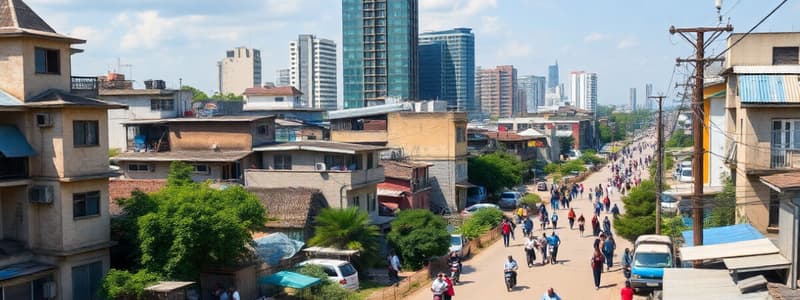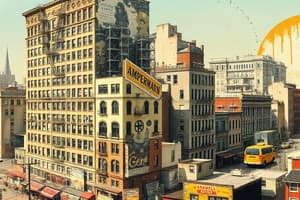Podcast
Questions and Answers
What is the primary factor that defines the process of urbanization?
What is the primary factor that defines the process of urbanization?
- An increase in agricultural output in rural areas.
- A decline in urban infrastructure development.
- A rise in the proportion of people residing in urban areas. (correct)
- A decrease in the number of people living in rural areas.
Which of the following is NOT a push factor that contributes to rural-urban migration?
Which of the following is NOT a push factor that contributes to rural-urban migration?
- Occurrence of natural disasters such as floods or droughts.
- Limited availability of land for farming.
- Prevalence of poverty and low income levels.
- Presence of significant job opportunities in rural areas. (correct)
What is a key characteristic of 'slums' that commonly develop as a result of urbanization?
What is a key characteristic of 'slums' that commonly develop as a result of urbanization?
- Areas with high-quality, modern infrastructure.
- Overcrowded regions lacking adequate housing and sanitation. (correct)
- Well-planned residential areas with low population density.
- Geographic regions with a surplus of resources.
Which of these is generally considered a positive impact of urbanization?
Which of these is generally considered a positive impact of urbanization?
Which of these best defines a 'megacity'?
Which of these best defines a 'megacity'?
The gradual increase in the proportion of people living in urban areas compared to rural areas is known as ______.
The gradual increase in the proportion of people living in urban areas compared to rural areas is known as ______.
A major reason for rural-urban migration is the lack of ______ opportunities in rural areas.
A major reason for rural-urban migration is the lack of ______ opportunities in rural areas.
Improved infrastructure like transportation and sanitation are considered ______ factors that attract people to urban areas.
Improved infrastructure like transportation and sanitation are considered ______ factors that attract people to urban areas.
______ are overcrowded, poorly developed areas with inadequate housing and sanitation, often inhabited by migrants.
______ are overcrowded, poorly developed areas with inadequate housing and sanitation, often inhabited by migrants.
A very large city with a population exceeding 10 million people is called a ______.
A very large city with a population exceeding 10 million people is called a ______.
Explain how both 'push' and 'pull' factors contribute to rural-urban migration.
Explain how both 'push' and 'pull' factors contribute to rural-urban migration.
How can urbanization simultaneously result in both economic development and environmental degradation?
How can urbanization simultaneously result in both economic development and environmental degradation?
Describe what distinguishes a 'rural area' from an 'urban area' based on key characteristics?
Describe what distinguishes a 'rural area' from an 'urban area' based on key characteristics?
What are the primary social impacts, both positive and negative, that arise from rapid urbanization?
What are the primary social impacts, both positive and negative, that arise from rapid urbanization?
How does the increase in population of urban areas place pressure on existing infrastructure?
How does the increase in population of urban areas place pressure on existing infrastructure?
Flashcards
What is Urbanization?
What is Urbanization?
The process where more people live in cities and towns than in rural areas, mainly due to people moving for better opportunities like jobs and education.
What is Rural-Urban Migration?
What is Rural-Urban Migration?
This is the main reason for urbanization: people leaving villages for cities to find better jobs, education, healthcare, and a better quality of life overall.
What are Push Factors?
What are Push Factors?
These are factors that push people to leave rural areas. Examples include limited land for farming, poverty, few jobs, and natural disasters.
What are Pull Factors?
What are Pull Factors?
Signup and view all the flashcards
What is a Megacity?
What is a Megacity?
Signup and view all the flashcards
Why do people migrate to cities?
Why do people migrate to cities?
Signup and view all the flashcards
What are Push Factors in Urbanization?
What are Push Factors in Urbanization?
Signup and view all the flashcards
What are Pull Factors in Urbanization?
What are Pull Factors in Urbanization?
Signup and view all the flashcards
What are Slums?
What are Slums?
Signup and view all the flashcards
Study Notes
Urbanization: Definition and Causes
- Urbanization is the increasing proportion of people living in urban areas (cities and towns) compared to rural areas.
- The primary driver is rural-urban migration, with people seeking better employment, education, healthcare, and improved quality of life.
- Natural population increase within urban areas also contributes significantly to growth.
- Urbanization leads to the expansion of urban areas and the development of new towns.
- Urbanization is a gradual increase in the proportion of people living in urban areas.
Factors Driving Urbanization
- Push Factors (Rural):
- Limited land for farming
- Poverty and low income
- Scarcity of employment opportunities
- Natural disasters (floods, droughts)
- Pull Factors (Urban):
- Industrial jobs and economic opportunities
- Access to better education and healthcare facilities
- Improved infrastructure (transportation, sanitation)
- Better quality of life
Impacts of Urbanization
- Positive Impacts:
- Economic growth through industrialization and service sectors
- Improved access to education and healthcare
- Cultural exchange and innovation
- Negative Impacts:
- Overcrowding and congestion
- Slum development (inadequate housing)
- Environmental degradation (air and water pollution)
- Strain on infrastructure (water supply, sanitation)
- Social problems (crime, poverty)
Related Terms
- Urban Area: Densely populated region with buildings and infrastructure, encompassing cities and towns.
- Rural Area: Low-density region primarily involved in agriculture.
- Megacity: A very large city with over 10 million inhabitants.
- Slums: Overcrowded, poorly developed areas with poor housing and sanitation, often populated by migrants.
Studying That Suits You
Use AI to generate personalized quizzes and flashcards to suit your learning preferences.



